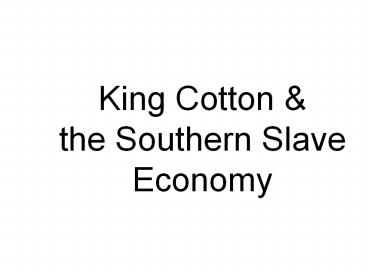King Cotton PowerPoint PPT Presentation
Title: King Cotton
1
King Cotton the Southern Slave Economy
2
The Rise of King Cotton
Southern cotton fueled the English American
Industrial Revolutions
- King Cotton was the dynamic force driving the
American economy from 1790-1840 - The South provided ¾ of worlds cotton
- Slave population grew 300
- Southern cotton stimulated Northern industry The
North dominated cotton textiles, shipping,
marketing
3
The Value of Cotton Exports as a Percentage of
All U.S. Exports
4
The Rise of King Cotton
- The introduction of short-staple cotton
strengthened and changed the American economy - Cotton could now be grown anywhere in the South
- The cotton gin (1793) made seed extraction easy
- The potential for profits led to a cotton boom
the expansion of slavery in the South
Southern way of life
White Southerners perceived their economic
interests to be tied to slavery
5
Slaves Using the Cotton Gin
6
Southern Agriculture
Cotton expansion led to Alabama Fever
from 1816 to 1820
Southern expansion boomed again from 1832 to 1838
into Mississippi, Louisiana, Arkansas
and again in the mid-1850s into Texas
7
Slave Concentration, 1820
Slave Concentration by 1860
8
Slavery in a Changing World
- Antebellum regional differences
- By 1820, all Northern states abolished slavery
- The South lagged behind the North in cities,
industry, railroads - Southern population grew slower than in the North
West
The South lagged by choice because these were
risky investments, but cotton was safe
Southern politicians feared being permanently
outvoted in Congress
By 1860, only 35 of railroads were in the South
By 1860, only 15 of U.S. factories were in the
South
PowerShow.com is a leading presentation sharing website. It has millions of presentations already uploaded and available with 1,000s more being uploaded by its users every day. Whatever your area of interest, here you’ll be able to find and view presentations you’ll love and possibly download. And, best of all, it is completely free and easy to use.
You might even have a presentation you’d like to share with others. If so, just upload it to PowerShow.com. We’ll convert it to an HTML5 slideshow that includes all the media types you’ve already added: audio, video, music, pictures, animations and transition effects. Then you can share it with your target audience as well as PowerShow.com’s millions of monthly visitors. And, again, it’s all free.
About the Developers
PowerShow.com is brought to you by CrystalGraphics, the award-winning developer and market-leading publisher of rich-media enhancement products for presentations. Our product offerings include millions of PowerPoint templates, diagrams, animated 3D characters and more.

